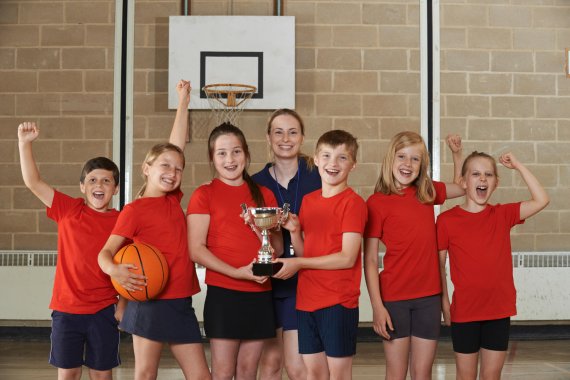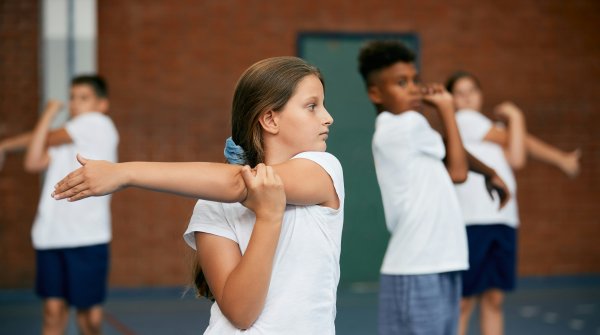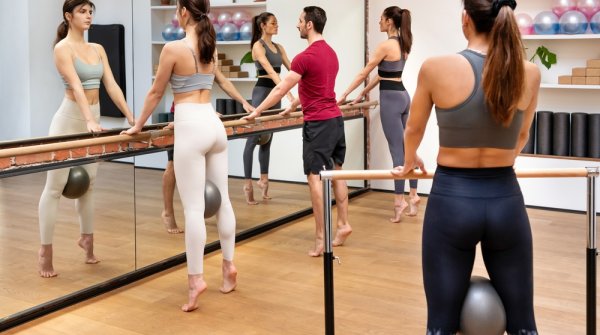
It’s a Thursday, during the seventh and eighth period; ninth grade physical education. The teacher is very upset: a quarter of the class didn’t report and – despite several warnings – decided to cut class. A few students are pulling exercise mats from the storage room, visibly unenthusiastic; the others are playing around on their cell phones.
Two girls don’t want to participate – citing “stomach cramps” – others are loitering in the locker room or are just arriving in drips and drabs. Twenty minutes tick by until all students are ready and the class can start. The rest is spent with calling everyone to order, explaining the exercises, and set up and break down of the equipment.
Times of limited budgets
In the end, these kids had a total of twelve minutes of actual physical activity during this double school period. The result? Physical education class: poor; students: frustrated. Many students actually enjoy sports, and physical activity is enjoying an increasing status in society, but most youths consider phy ed in schools boring and uninspiring.
“I hate phy ed class,” one girl says. “At the moment we are doing apparatus work, and I try to get out of it as often as I can. I either use the excuse that I forgot my workout clothes, or I just stay home.”
In times of limited budgets many educational sports facilities are rundown, the equipment outdated, and the curriculum is non-specific. Physical education is considered a “soft subject”, is often associated with leisure time activities and dismissed as unimportant. Parents aren’t the only ones who question the value of phy ed classes; they believe that Math and English are more important.
Teaching methods are criticised
“Whenever classes are cancelled, it is usually physical education that gets axed first,” confirms Günter Stibbe, Professor of Sports Didactics and School Sports at the German Sports University (Deutsche Sporthochschule - DSHS) in Cologne. “It would already be a step forward if the three hours that most German states budget per week would actually happen.”
In fact, the actual amount of time spent each week for physical education is only 2.2 hours. This is according to the Sprint Study 2006, performed by the German Olympic Sports Confederation (Deutscher Olympischer Sportbund - DOSB), Germany’s only study on physical education in schools.
“We have to heal this wound”
In the study, the authors criticized that most physical educators were too old and that it was therefore difficult to teach trend sports. Since then, not much has changed when it comes to school sports: experts even profess that they are not surprised that there hasn’t been another study.
“It is quite disturbing what happens in school sports,” was a recent comment by Andreas Rettig, the General Manager of the German Soccer League (DFL); he demanded: “we have to heal this wound”. He believes that social issues such as obesity are a result of neglecting physical education.
Is school making children fat?
Even though sports traditionally have a different status than in Germany in countries like Canada, Great Britain, France or the USA, it is not easy to reach all student groups and motivate everyone to consider sports and exercise a long-term philosophy.
Are we squandering an important opportunity? According to estimates, two thirds of all children around the globe exercise too little – and counting. By now, lack of physical activity has established itself as the central health problem of the third millennium.
The US Department of Health and Human Services advised that it is essential for schools to collaborate in the attempt to stop and reverse this trend. Despite parents, teachers and physicians admonishing young people for years to increase their level of physical activity, the majority still has less than the recommended 60 minutes of activity per day.
Obesity on the rise
“We have to adopt drastic measures to change this,” says Russel Pate, sports scientist at the University of South Carolina. “School is the best place to start. After all, this is where kids spend six or seven hours each day.”
Nowhere else in the world are there more adolescents suffering from obesity than in the USA: 17 percent of US children and youths are considered obese, three times as many as 30 years ago. According to estimates, every third child of school age around the globe is overweight.
Too few healthy foods
A study by the University of Mainz showed that many German children are overweight when they start school. Up to their fifth birthday their weight is about the same as 20 years ago, however, their weight increases considerably in the years that follow, so the researchers.
The reason has not yet been discerned. More research is required; after all, this is about more than just being chubby during childhood: overweight young people often stay as such for the rest of their lives.
Initiatives in the battle against obesity
There are plenty of initiatives and projects in the battle against obesity and lack of activity. The Chinese, Americans and British are attempting to use dancing in schools to slim down their kids.
A few years ago, Great Britain launched a pilot project, inspired by the “Strictly Come Dancing” competition many young and old British television viewers enjoy every weekend. According to the responsible ministry the goal is to become the “first significant country” to defy the obesity trend with sports and healthy nutrition.
By 2020 the number of obese youngsters is to be reduced to the level of the year 2000 with the help of waltzes, cha-cha and salsa dancing.
No chance for the underprivileged
Nowadays, the weak, slow and overweight are yet almost automatically sorted from their group of peers. Unfortunately, they often have to endure painful moments while kept waiting on the bench until the very end of a team selection.
Conversely, these are the students who would benefit the most from physical education. Sports scientist Stibbe observed that currently there are basically two groups of students, “those with a high level of experience in physical activity, gained in clubs or from playing informal sports like skating, and those with strong physical activity impairments.
These are usually youths who also suffer disadvantages in the education system. In addition, girls with a migratory background hardly ever join sports associations.”
Fitness and performance is not everything
An aggregating fact seems to be that many physical education teachers are ambitious athletes who turned their hobby into a profession, adds Claus Buhren, Director of the Institute for School Sports and Academic Development, also of DSHS Cologne.
They often focus on performance rather than endorsing individual strengths and encouraging students to discover the benefits of exercise. Phy ed class – even adults shiver when recalling loud whistles and military drills, the blue mats in front of the parallel bars and the line of students waiting for their turn.
Stibbe demands: “We have to shatter the outdated image of physical education in schools. There also is a pedagogic mission: it can help solve the overall challenges of school on a physical level. Western culture has long neglected the body; the focus has been on the mind.
Motivation for sports and excercises
What isn’t taught in school is very hard to convey at a later point in life. If all works out as it should, physical education conveys motivation for sports and exercise that lasts a whole life.”
An example how this concept can work is the PE4Life program at the Naperville Central High School in the US state of Illinois. The curriculum includes fitness instead of sports, and teaches it every day.
Students not only develop healthy life habits, athletic abilities and appreciation for exercise, they also learn how their bodies work. They wear heart rate monitors during exercise, and learn about the recommended target values for heart rate, body fat and blood pressure. Their frequent evaluation shows the positive effect of exercise.
Aerobic equipment
The high school’s gymnasium looks like a fitness club. The weight training equipment is customized for the requirements of adolescents, and there are immense climbing walls, and aerobic equipment with digital consoles.
Students can also select from courses like kayaking, hiking or dancing. The philosophy is to increases the chance that everyone can find something they will enjoy and make them feel good while reaching an adequate performance level.
If children have no choice and are forced to play, for example, basketball, a sport that might not be their forte, they will consider it a punishment and thus won’t continue it later, all sports education experts unanimously agree.
New approach for motivation
In the past even the Naperville curriculum included old-fashioned exercises. However, teachers observed that more than half of all students failed after as little as one pull-up and had to face the rest of the class as losers. The experts also took a closer look at other disciplines like team sports.
The verdict was scathing; most students ended up inactive. Sounds logical, you wait until the ball comes near you or it is your turn. That can take time, and you are just standing around waiting. Less than three percent of adults older than 25 play a team sport to remain fit, the statistics show.
Individual heart rate measurement
The guidelines at the high school were changed, and team size was decreased to force the team members to be more active: soccer is now four against four, basketball three against three. Individual performance is determined by monitoring how long each student remains within his or her target heart rate.
The concept works: Naperville students are physically fitter than the average US student and weight issues are rare.
The Naperville kids also have an advantage when it comes to academic performance. The “Zero Hour” experiment, held at the school and monitored by experts, gave proof: a group of students ran four laps on the track prior to the start of classes at 8 am – thus called Zero Hour – to generate a pulse rate of at least 185. The results? These students were able to improve their performance even in their weakest academic classes.
Fitness improves grades
Put on your workout clothes and running shoes, go outside, run for 30 minutes and come back a little smarter? Jogging instead of memorizing formulas and mental arithmetics? There may be some truth in this.
A variety of new research shows that body and mind benefit from physical training. Researchers from Sweden, for example, observed that additional physical education classes not only improve children’s motor functions but also their productivity and academic performance. “The difference between standard and expanded physical education is significant,” research director Ingegerd Ericsson emphasizes.
The researchers observed 220 Swedish students over the course of nine years. Half of them took daily physical education classes, the other half twice a week. 96 percent of the extra-athletic students passed the nine compulsory school years faster than the control group with 89 percent, while the difference was even more pronounced among boys with a ratio of 83 percent.
Physical performance is closely related to intelligence
The athletic group also gained better grades in Swedish, Math, English and Sports. In addition, 93 percent of these students exhibited well-developed motor functions, while – and this really is no surprise – the percentage in the other group was only at 53. A comparison study with 18-year-old twins, also in Sweden, showed that physical performance is closely related to intelligence.
The higher the youth’s physical fitness, the higher also the mental fitness. The experts from Stockholm commented that 15 percent may be attributed to genetics, and the other 85 percent to physical activity.
Muscles activate the brain
It was long thought that exercising one’s muscles had no effect on brain matter simply for biological reasons. The idea was that blood circulation and metabolic activity in the brain was almost automatically kept at the same level.
Today we know that the brain receives more oxygen during physical activity, which allows increased performance. Going for a walk increases blood flow in the brain by 20 percent, mid-level exercise by 30 percent. The increased circulation triggers increased protein production in the brain.
Many of these proteins are growth factors and act like a fertilizer for the brain. Frequent physical activity over a long period of time can trigger effects that actually change brain structure.
No development without exercise
Exercise strengthens existing brain cell connections and supports the building of new synapses and structure changes. Performance athletes, for example, exhibited a considerably higher level of gray matter in a variety of areas of the brain, discovered researchers at the University of Bochum.
A study at the TU Dresden suggests that the experiences related to exercise play a role in the structure change process. Using mice in lab tests the researchers observed that the brains of animals that were very active over long periods of time remained fitter over the years than those of less active mice.
Therefore scientists believe that physical exercise in itself trains the brain and has an effect on the creation of new brain cells. After all, it is an indispensable principle for the development of the brain while growing up. No progress without exercise.
- ISPO awards
- Mountain sports
- Bike
- Design
- Retail
- Fitness
- Health
- ISPO Job Market
- ISPO Munich
- ISPO Shanghai
- Running
- Brands
- Sustainability
- Olympia
- OutDoor
- Promotion
- Sports Business
- ISPO Textrends
- Triathlon
- Water sports
- Winter sports
- eSports
- SportsTech
- OutDoor by ISPO
- Heroes
- Transformation
- Sport Fashion
- Urban Culture
- Challenges of a CEO
- Trade fairs
- Sports
- Find the Balance
- Product reviews
- Newsletter Exclusive Area
- Magazine






